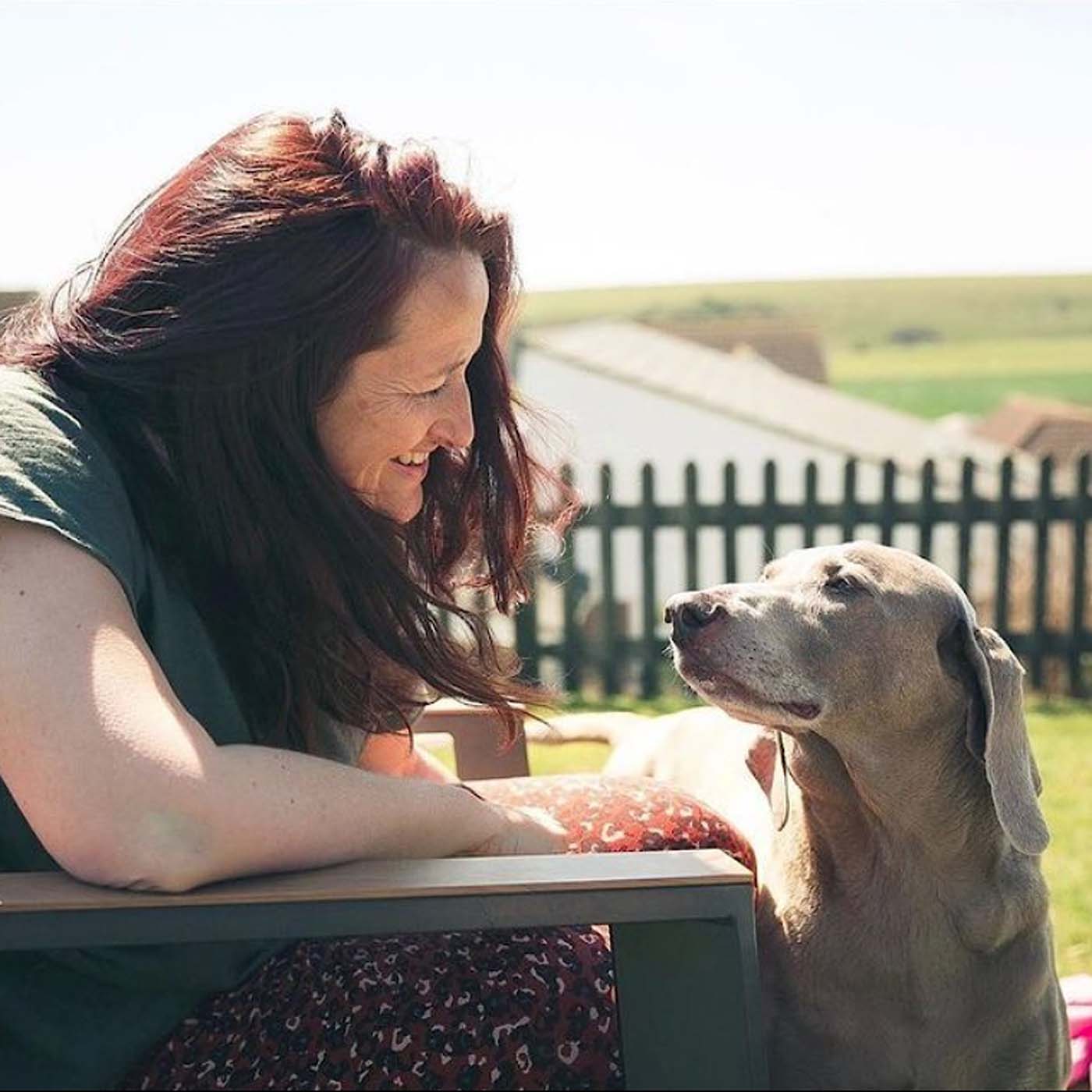Meet Rachel Knott - holistic animal therapist
I first met Rachel back in 2016 at one of her workshops, where she was teaching us all about a practice called Applied Zoopharmacognosy, and showing how it can help our pets. It was a really eye opening and insightful workshop; Rachel clearly had a talent for understanding an animal’s needs and being able to connect with them. So, I was keen to ask her a few questions in order to share her wisdom and experiences so that we can all learn to understand our pets and their needs that little bit better.
Hi Rachel, firstly could you introduce yourself?
My passion and purpose is to help people and their animals live a more effortless, authentic, connected and vibrant life. I especially love watching people find their purpose when working with dogs and the ripples they create as they go out and support other dogs and their guardians.
I’m mum and friend to my own dogs, both here and in spirit, the Founder of My Animal Matters which provides on-line learning for those wishing to become an accredited practitioner in Botanical Self-Healing, as well as an online botanicals shop.
Have you always worked with animals?
No, I dipped my toe into the corporate world for about 5 years until the moment where I sat at my desk and looked at my sales targets on the wall next to me and thought, “I have absolutely no idea what the point of any of this is!” And this is where it all began to unfold as weeks later, I was made redundant. Being in fortunate situation where I didn’t need to earn money immediately, I felt drawn to volunteer at Battersea Dogs home as all I knew at that point was, I love dogs and I want to do something I love. That was in 2000 and I’ve been working alongside dogs ever since. From running a day-care to studying dog behaviour, Zoopharmacognosy (I call it Botanical self-healing as it rolls off the tongue with greater ease!), running workshops and talks on botanical self-healing, reiki, animal communication, I now LOVE facilitating other’s learning so they can go on to support dogs and their guardians.
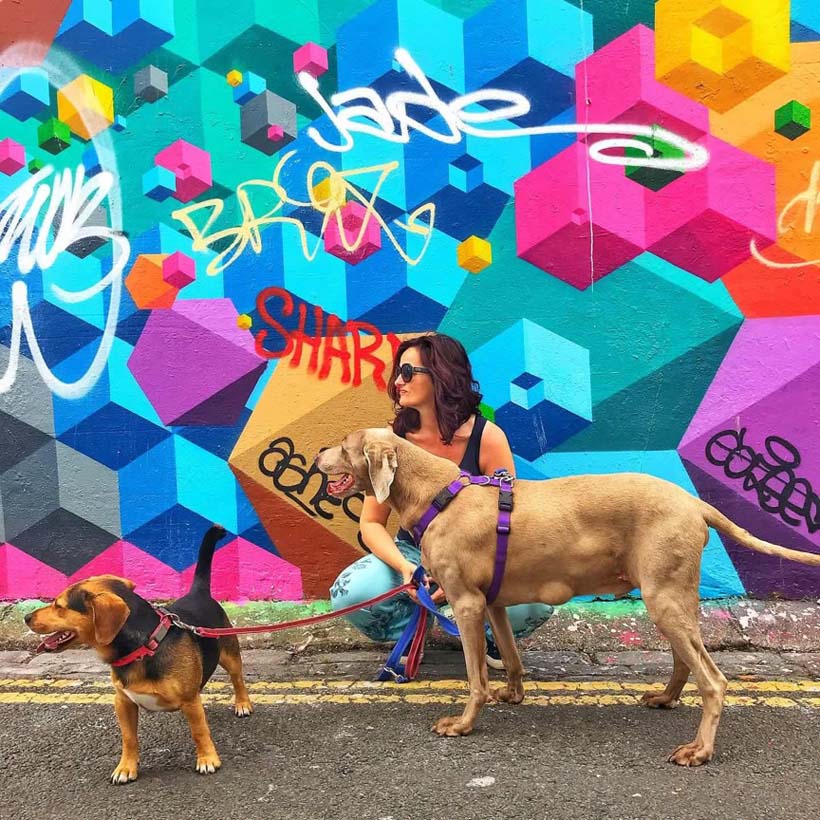 Rachel’s love of dogs spurred her to create a life centred around learning from and helping animals.
Rachel’s love of dogs spurred her to create a life centred around learning from and helping animals.
When did you first come across Applied Zoopharmacognosy and feel the calling to follow that path?
I was on a dog behaviour course with Sheila Harper and she brought in Caroline Ingraham who pioneered this work and my jaw pretty much hit the floor when I saw how beautifully each dog responded to being offered the herbs and aromatics. It felt like I’d come home to myself and my calling. It seemed the most natural and empowering thing for the dogs. It was the start of my exploration of this work and how transformational it can be when we start to truly listen and be guided by our dogs, the plants and our innate wisdom to self-heal.
Can you explain what Applied Zoopharmacognosy is, and how you apply it to help animals.
In a nutshell, all animals have the ability to self-heal with the support of plant medicine. Us included. They are innately drawn to certain medicinal plants to help them heal and maintain good emotional and physical health.
In its simplest form, when dogs go out to graze on grass, they don’t just eat any and all grasses, they are very particular about which blades, how much they what and when. This is botanical self-healing in action. But we can take this further by bringing in a selection of aromatic plants in the form of essential oils and hydrosols and dried herbs so that our animals can then guide the process entirely.
There are no limits to what this can help with but I’d say the biggest thing is anxiety, change, fear, frustration, discomfort and end of life.
The animals have this innate wisdom, so we can start to listen and learn from them and let them lead the way.
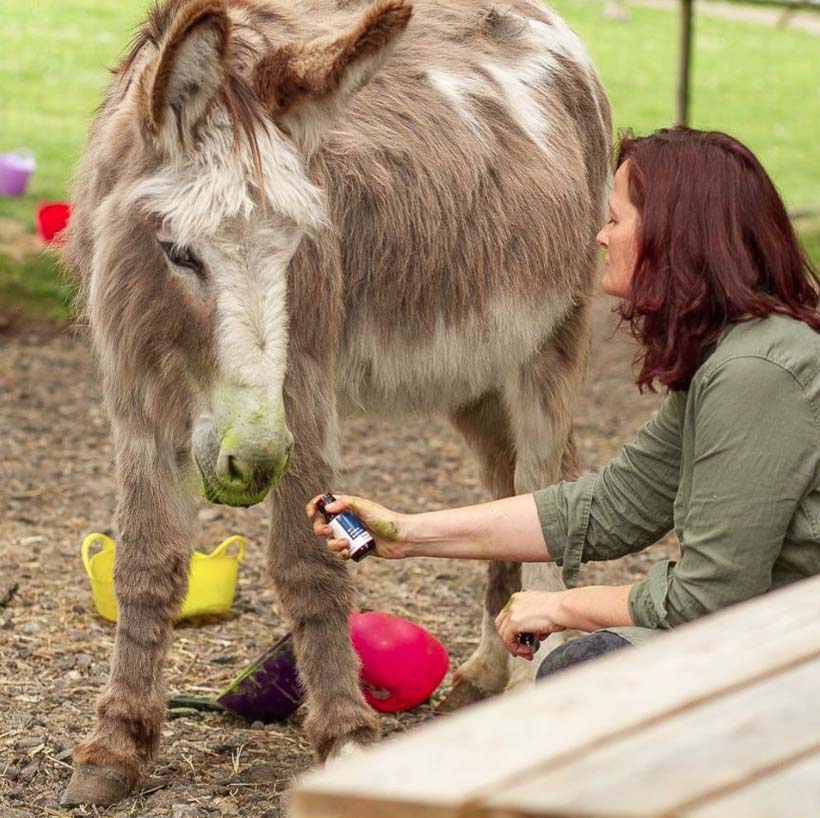 Rachel works with all kinds of animals, helping them to find ease and letting them guide their own healing.
Rachel works with all kinds of animals, helping them to find ease and letting them guide their own healing.
What’s your take on conventional dog training. How do we work with our pets in an harmonious way to bring out the best in them?
I see that we live in a symbiotic relationship with all beings, plant and animal. So when we recognise that we are all supporting each other and we’re all connected, then we are naturally more likely to understand the co-creative nature of the relationship with our dogs.
Of course, it’s important to teach them some basics to keep them safe in our domesticated world, but beyond that, my goal and role is to listen.
To listen to what they are showing me about their needs so I can support them but equally important is to recognise what they are showing me about myself. As a mirror. This way of being with animals creates long-lasting authentic deep healing where both beings can thrive.
I believe it’s an illusion that we control anything in life, rather we co-create everything.
So this shift in perspective can help us transform our relationship with our animals where fear and anxiety and frustration cease to exist. And harmony, empathy and a supportive co-creative relationship can thrive.
Tell me more about Baxter and the journey you had with him, especially the things he taught you over the years.
That is likely a book so I’ll try to keep this short! He was and is one of my best friends. He died in 2021 in the late summer. He took himself out into the garden and passed away peacefully with a feather against his nose and the sun on his body. I couldn’t have wished for a more beautiful passing for the most wonderful being.
Baxter was my buddy as I learnt about the different healing modalities in the animal world. But the biggest lesson he taught me was my own self-healing journey. That while all my focus was on him, I wasn’t appreciating that he was also guiding me. It was once I started to truly appreciate the importance of this that he really started to thrive in himself. Issues like ‘separation’ ‘itchy skin’ ‘ear infections’ simply ceased to exist. The botanicals all helped him self-heal but because dogs are always honestly expressing everything that’s in their eco-system, while I was ‘in conflict’ with myself, certain challenges remained. Until I listened and started to self-heal. I changed, he changed. He changed, I changed. All of his ‘challenges’ lead me in different directions helping me acquire knowledge and wisdom which I then go on to share with others.
And most of all, that life can be serious but should not to be taken too seriously at all.
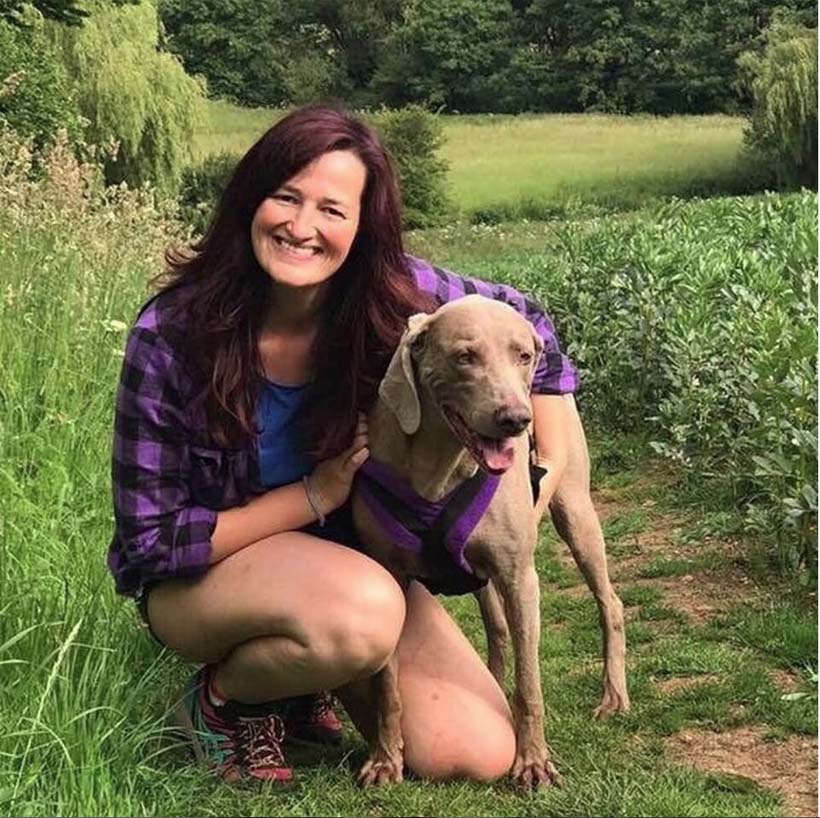 Rachel with her best friend Baxter.
Rachel with her best friend Baxter.
You talk a lot about the importance of listening to our animals. How does that work in practice, how can people learn to listen more to their pets?
Most people start with learning about body language and how dogs will communicate. This is where I began. But then when I started to work with the botanicals, my intuitive senses really opened up and I was able to listen beyond what I was observing with my eyes. And that’s when I really started to witness changes in the animals and their guardians.
We tend to focus on what we see and language, but of course animals FEEL everything and express what they feel, so this for me is the most important language and skill to build on and practice. Our feeling skills.
When I was running a botanical self-healing workshop, I saw a dog go from high stress repetitive shadow chasing to sleeping in the middle of the room as the guardian, with the help of a bottle of ginger essential oil, accessed an uncomfortable emotion she’d been controlling for so long. It was such a penny drop moment and a beautiful confirmation that the most important skill we need to develop is to listen and keep listening to what our animals are showing us. Using all of our intuitive senses.
It takes an open and curious mind first of all and a desire to learn more deeply about our animals physically, emotionally and energetically. It’s exciting when we do this as they take our understanding to a whole other level.
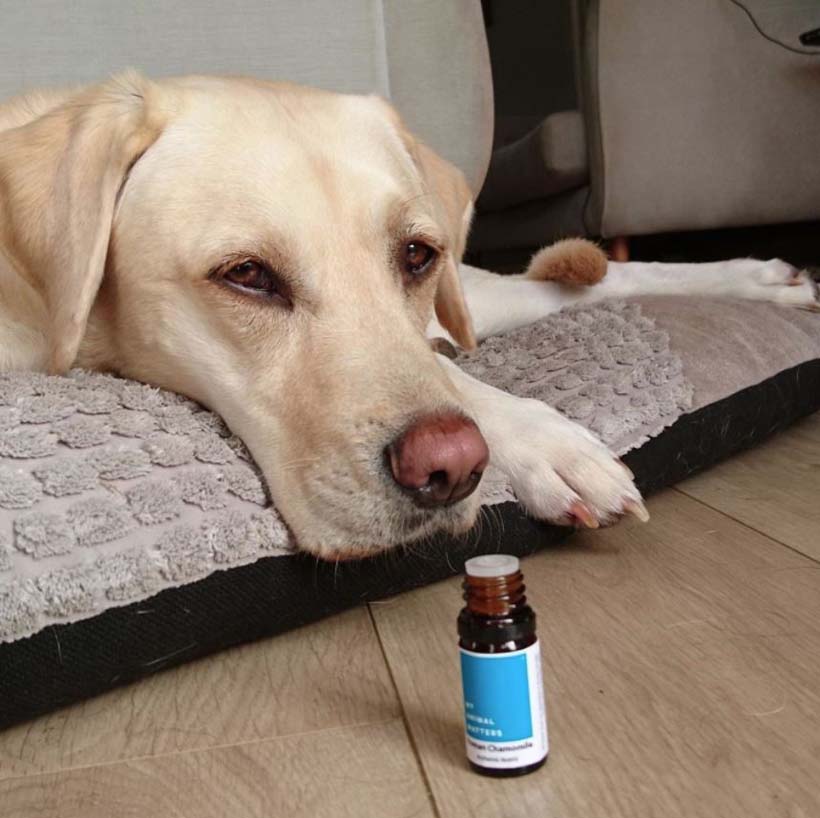 Golden Labrador Honey using Roman Chamomile to ease feelings of anxiety and find her calm.
Golden Labrador Honey using Roman Chamomile to ease feelings of anxiety and find her calm.
You must have helped hundreds of animals over the years. Are there any stories which hold a special place in your heart which you’d like to share with us?
Yes. Duke was a mastiff x Great Dane and he’d been at Oxfordshire animal sanctuary for 4 years. Only one lady could go into his kennel area as he had been so badly abused. He would hide at the back of his kennel whenever anyone walked past and cower. I had no idea if I could make any difference but I knew I wanted to find out.
For 90 minutes, all I could see, as his kennel was quite dark, were his eyes and I was guided by what I felt from him. He went between Jasmine and Linden Blossom essential oils, just inhaling them in the most subtle way.
I left wondering if anything had changed. The next day, his handler messaged me to say for the first time in 4 years, he was looking out of his little window watching life go by, instead of hiding. WOW!
And then the next week I found him a home with 2 fellow botanical / behaviour colleagues. What a shift!
I just want to stress that it doesn’t always have to be so ground breaking. Botanical self-healing is something that we can all access to help our animals self-heal. There doesn’t really have to be anything ‘wrong’ for you to dive into this work because the process alone of offering aromatics and herbs to our animals is deeply enriching to their lives. Domesticated animals, for the most part, have little choices. And this is a natural way that they KNOW to help them make choices, communicate their needs and indeed have their emotional, physical and spiritual needs met.
Simply sitting quietly in a space with our animal, sharing and connecting with the aroma of their and our favourite essential oil really can deepen our bond and our connection. It doesn’t require words or action. Just presence and listening. And it’s in this space that things can start to shift. That for me is the beauty of this process.
A lot of animals find fireworks especially distressing. What would be your recommendations for helping them navigate events such as bonfire night?
From a botanicals perspective, I would find out in advance what your animal’s favourites are. As chances are, this is what will help them cope better with things that distress them. Popular ones are valerian essential oil, St. John’s wort hydrosol, rose and vetiver essential oils. It’s important to find out in advance which ones your animals need and prefer so you can be prepared.
Having seen my own dog self-heal from a ‘firework phobia’, I equally know the importance of listening to what comes up for us when they get distressed. As they will also be picking up on the stuff we’ve managed to suppress. This isn’t talked about enough and I believe it’s a crucial part of supporting our animals.
What are your ‘go to’ botanicals (a few select items which would be good for anyone to have to hand) and what can they help with?
Now, that’s a tough question because it’s soooo unique. But as you’ve pinned me down on this, I’ll keep it to 5!
1. Yarrow essential oil. I mean, what a powerhouse of a plant! Her wound healing properties are second to none.
2. Peppermint. Simple, clear, uplifting, clearing, stomach soothing, expansive. Wonderful for those with stuffy noses, nausea, headaches and so much more!
3. Green clay powder. With so many animals having itches, green clay can magically soothe and clear heat and itching. I’ve used it for open wounds, sores, itchy skin and ears. Wouldn’t be without green clay!
4. Violet leaf absolute. For some reason, this one is THE most popular with dogs, in particular. She has a very earthy, green, herbaceous aroma so can create a very grounding feeling while also having some anti-inflammatory properties for those with discomfort
5. Rose. Who doesn’t love rose! She’s gentle, cooling, nurturing, loving and so much more. Every being wants to feel love and rose just embodies this so beautifully. Either the Rose Otto essential oil or the hydrosol.
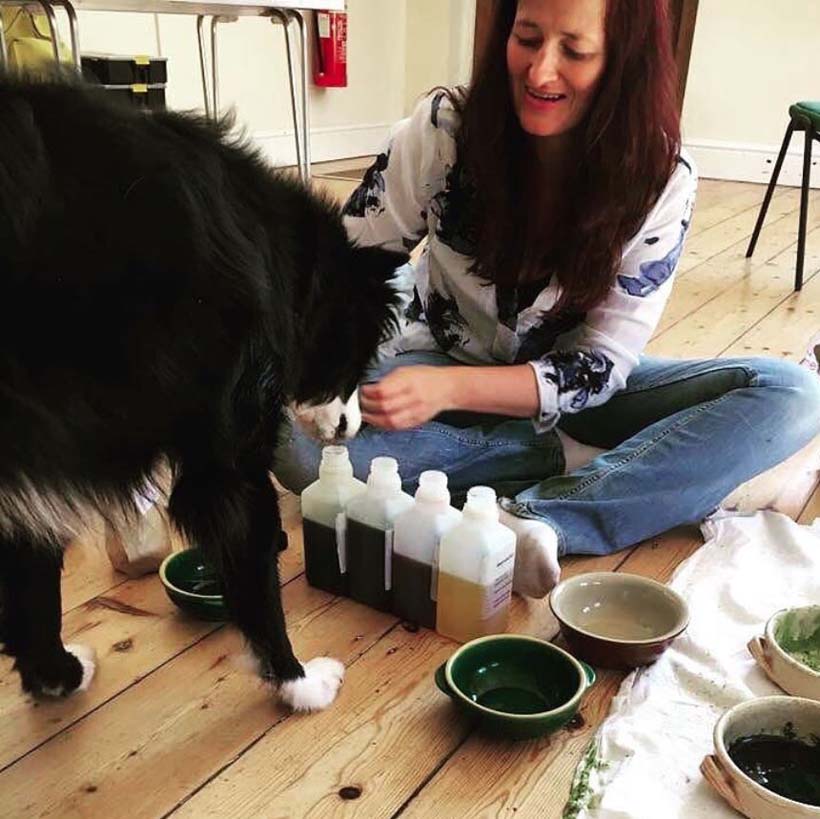 Rachel working with border collie Maffy in one of her workshops.
Rachel working with border collie Maffy in one of her workshops.
What would you say is the most important thing that animals have taught you over the years?
Listen and keep learning without getting attached to a specific outcome. And that everything, even the challenges and triggers, are all here to help each of us grow together as a connected community.
Every animal is different and unique and that’s why in the animal world, and indeed the human world, one plus one never equals two. There is no one elixir or formula. Just keep learning and exploring and feel your way through life with your animals. Don’t overthink it!
If people want to learn more about your work and how it can help the animals in their own lives, where should they go?
You can find me via my website which is www.myanimalmatters.co.uk and I’m on Facebook and Instagram too.

